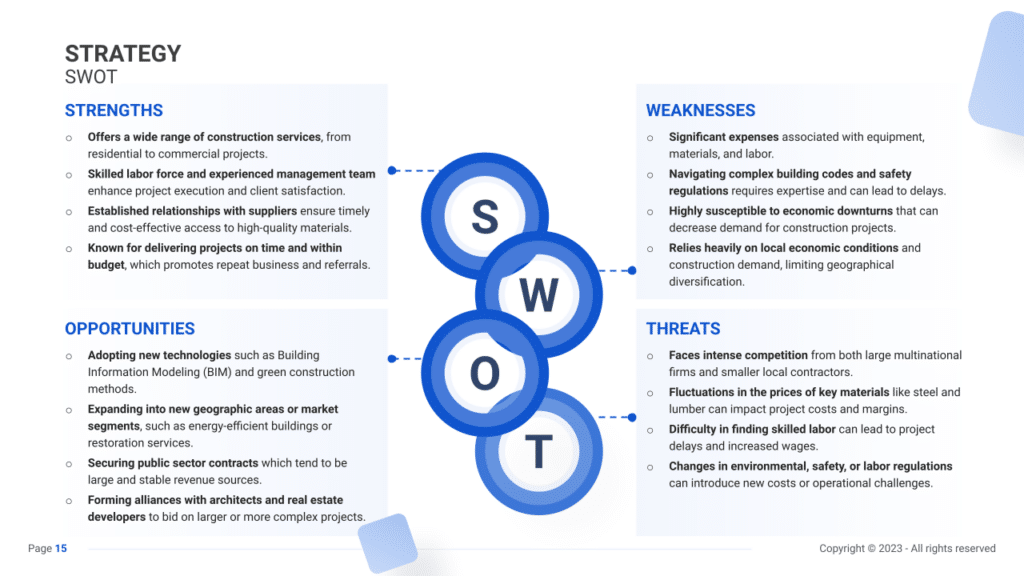How to Prepare a SWOT for a Construction Contractor

A pivotal step in formulating a robust business plan for a construction contractor involves conducting a SWOT analysis. SWOT (Strengths, Weaknesses, Opportunities, and Threats) offers a structured approach for contractors to evaluate both internal capacities and external factors shaping their industry.
Internal aspects like a skilled workforce and cutting-edge equipment constitute strengths and weaknesses, while external dynamics such as market trends and regulatory changes encompass opportunities and threats.
In this article, we will delve into diverse examples illustrating strengths and weaknesses specific to construction contractors, providing valuable insights to integrate into their business strategies effectively.

Strengths
Uncover the inherent strengths that set Construction Contractor Services apart, laying the groundwork for unparalleled success.
- Skilled Workforce: Construction contractors boast a skilled and experienced workforce, ensuring efficient project execution.
- Example: Showcasing employee certifications and industry expertise builds client trust and attracts high-profile projects.
- Proven Track Record: A robust portfolio of successful projects serves as a testament to a contractor’s reliability and competence.
- Example: Creating a compelling project portfolio on the company website highlights past achievements, instilling confidence in potential clients.
- Diverse Service Offerings: Contractors often provide a range of services, from design to project management, offering comprehensive solutions.
- Example: Promoting integrated services, such as turnkey solutions, positions the contractor as a one-stop-shop for clients’ construction needs.
- Strong Supplier Relationships: Established connections with reliable suppliers ensure a steady flow of quality materials and timely deliveries.
- Example: Showcasing long-term partnerships with reputable suppliers emphasizes the commitment to quality and reliability.
Weaknesses
Addressing weaknesses is paramount for construction contractors to enhance their capabilities and deliver superior services.
- Weather Dependency: Construction projects are susceptible to weather disruptions, impacting timelines and project schedules.
- Example: Implementing contingency plans for adverse weather conditions minimizes project delays and mitigates associated risks.
- High Equipment Costs: The need for specialized equipment can pose a financial challenge, impacting profitability.
- Example: Exploring equipment leasing options or forming partnerships with equipment rental companies can alleviate the financial burden.
- Skilled Labor Shortages: The construction industry often faces shortages of skilled labor, impacting project timelines.
- Example: Investing in training programs or collaborating with local vocational schools helps address the labor shortage and ensures a skilled workforce.
- Project Delays and Overruns: Unforeseen circumstances can lead to delays and cost overruns, affecting client satisfaction.
- Example: Implementing robust project management systems and maintaining transparent communication minimizes the risk of delays.
Opportunities
Identifying and capitalizing on opportunities positions Construction Contractor Services for sustained growth and prosperity.
- Green Construction Trend: The growing demand for sustainable construction presents an opportunity to embrace eco-friendly practices.
- Example: Offering green construction solutions and obtaining relevant certifications positions the contractor in alignment with environmental trends.
- Technological Integration: Incorporating cutting-edge construction technologies enhances efficiency, accuracy, and project outcomes.
- Example: Embracing Building Information Modeling (BIM) technology streamlines project planning and execution, offering a competitive edge.
- Infrastructure Development: Participating in large-scale infrastructure projects or public-private partnerships taps into expansive growth opportunities.
- Example: Actively pursuing government contracts and forming alliances with key stakeholders opens avenues for involvement in major infrastructure initiatives.
- Expansion into Niche Markets: Exploring niche markets, such as specialized construction or regional expansions, diversifies the contractor’s portfolio.
- Example: Entering niche markets like historic preservation or sustainable construction caters to specific client needs and broadens market reach.
Threats
Anticipating and mitigating threats is crucial for Construction Contractor Services to navigate challenges and ensure long-term success.
- Economic Downturns: Economic uncertainties may impact construction budgets and lead to a decline in project demand.
- Example: Diversifying into renovation projects or entering affordable housing initiatives provides stability during economic downturns.
- Regulatory Changes: Evolving construction regulations may pose challenges, necessitating adaptation and compliance efforts.
- Example: Regularly updating compliance protocols and conducting staff training ensures adherence to changing regulations like Hazwoper for example
- Intense Competition: The highly competitive nature of the construction industry may lead to pricing pressures and reduced profit margins.
- Example: Focusing on value-added services, such as innovative project management approaches, justifies premium pricing and differentiates the contractor.
- Material Price Volatility: Fluctuations in material prices impact project costs, potentially affecting profitability.
- Example: Negotiating long-term contracts with suppliers or exploring alternative materials mitigates the impact of price volatility.





